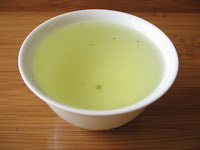Tea: Kuradashi Gyokuro Super Premium
Vendor: Hibiki-anPrice: $24.00/ 40g
Source: Uji, Japan
About This Tea: This tea is a Kuradashi tea. Kuradashi teas are teas that have been stored for a period of time to intentionally age the tea. This was stored for 18 months before packaging.
Leaf: The leaf for this tea has a lightly grassy aroma. The leaf is dark in color. The shape is very similar to the o-cha Yame Gyokuro.
1st Infusion Parameters: 5g, 140F, 5oz, 60s
1st Infusion: The first infusion had a pale green color to it. It was quite transparent with just a hint of color. The tea has a very unusual aroma, it's an almost woody aroma to it. There is a rich umami flavor to this infusion and it is much less grassy than most gyokuro. The flavor was lighter than many gyokuro, but it was still very full bodied. The flavor was predominantly a marine/seaweed flavor, which followed through from beginning to end.
2nd Infusion Parameters: 145F, 15s
2nd Infusion: This infusion had a much brighter color to it. There was a light amount of murkiness to it, and a radiant green color which reminded me a bit of shincha. The tea has a light dry aroma to it. The marine/seaweed flavor was dominant in this infusion as well. The tea is very smooth and enjoyable. There is no bitterness and no astringency to it. The flavor in this infusion was very consistent from beginning to end.
3rd Infusion Parameters: 150F, 45s
3rd Infusion: This infusion had a dusty aroma to it. The marine/seaweed flavor was also dominant in this infusion. There was still a good amount of umami flavor in it, but I noticed the empty wamer water flavor showing through.
4th Infusion Parameters: 160F, 90s
4th Infusion: This infusion had a clearer color to it. There was a much lighter flavor, but it felt a bit hollow. The thickness found in the earlier infusions and richness of umami flavor was lightening up and the flavor felt a bit hollow. There were still hints of the marine/seaweed flavor though.
Rating: 10/10
Conclusion: This is a very unusual gyokruo. The flavor was the most consistent throughout the infusions as I have ever seen. Even with the increasing temperature it was smooth with no sense of bitterness or astringency, a characteristic that tends to show up during later infusions. It felt very pure and clean throughout the whole time.
 Tea: Masala Chai
Tea: Masala Chai Infusion: This chai has a light and creamy chocolatey brown color to it. The aroma is very noticeably sweet and milky. The tea flavor is very well balanced between the milk / tea / sweetness. The flavor is very milky like a heavily milked black tea. There are hints of spiciness, but only light hinting. More tea may increase this flavor.
Infusion: This chai has a light and creamy chocolatey brown color to it. The aroma is very noticeably sweet and milky. The tea flavor is very well balanced between the milk / tea / sweetness. The flavor is very milky like a heavily milked black tea. There are hints of spiciness, but only light hinting. More tea may increase this flavor.


















